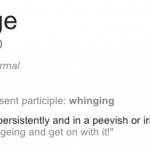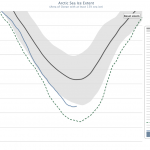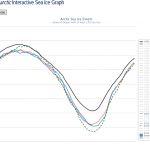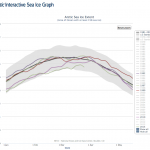Arctic Sea Ice Extent
Every year the sea ice that covers the northern part of the Earth expands and contracts though the winter and the summer. The minimum extent of the sea ice is usually reached some time in September, after which it starts to reform.
Human caused greenhouse gas pollution has increased the surface temperatures of the earth, as measured on the land at about heat height with thermometers, and on the sea at the surface, mainly with satellites. Warming of the surface has continued apace for several decades, though with some expected squiggling up and down in how fast that is happening.
Greenhouse…
The National Snow & Ice Data Center has declared that the Arctic Sea ice extent has reached its annual minimum and is now starting to expand. I was thinking that it was too early to say this, since in past years what looks like a minimum can sometimes be reversed by some additional melting. But they are the experts, so I suppose we should go with it for now.
If this is the case, then this is the fourth lowest minimum in the good data set covering the last several decades.
They do hedge a bit. Here is what they say:
On September 11, Arctic sea ice reached its likely minimum extent for…
September is when the melt of the Arctic Sea Ice stops, and the re-freeze starts. We are probably not at the minimum yet, but the amount of melting is starting to level off so we can see where we are. The above graphic, made here (go and play with the interactive graph) shows the first ten years of ice freezing and remelting in the data set to use as a baseline for comparison, and the present year. Yes, there is much less sea ice on the northern end of the planet than usual.
This version of the graph shows the years with less ice, so far, than the present year. This includes the famous 2012…
Above is the nifty interactive graphic from the National Snow and Ice Data Center showing sea ice extent in the Arctic for the current year (the lower squiggle). This year's squiggle looks like a peak, and it is possible that Arctic Sea ice extent is now on the decline. Minimum extent is typically reached in September.
The other squiggles are all the years since 1979 that seem to have had peaks later in the year than this year's apparent peak of a couple of days ago. Those years are 1992, 1997, 1999, and 2010. In other words, for the available data set, four out of 34 years, or just over…



